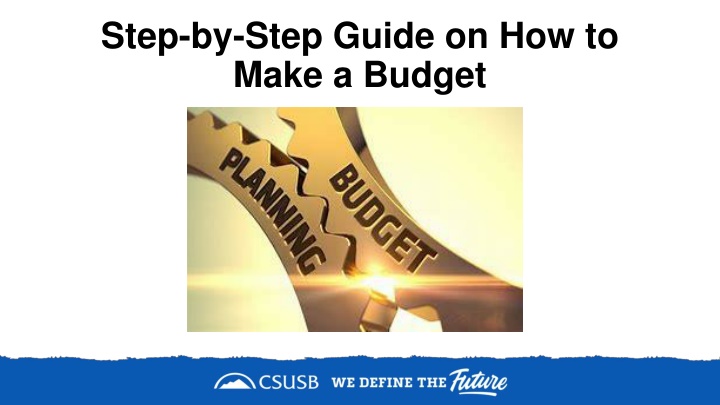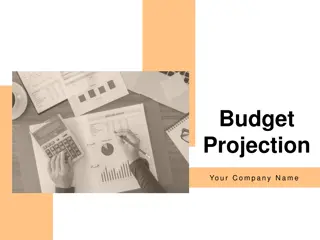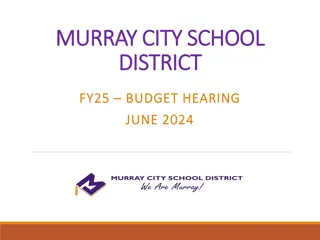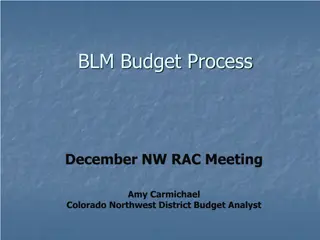Step-by-Step Guide on How to Make a Budget
Making a budget is crucial for managing your finances effectively. This step-by-step guide outlines key aspects such as determining income, calculating expenses, setting realistic goals, tracking spending, and choosing a budgeting plan. Understanding your budget helps you align your financial habits with your goals and priorities to achieve financial stability.
Download Presentation

Please find below an Image/Link to download the presentation.
The content on the website is provided AS IS for your information and personal use only. It may not be sold, licensed, or shared on other websites without obtaining consent from the author.If you encounter any issues during the download, it is possible that the publisher has removed the file from their server.
You are allowed to download the files provided on this website for personal or commercial use, subject to the condition that they are used lawfully. All files are the property of their respective owners.
The content on the website is provided AS IS for your information and personal use only. It may not be sold, licensed, or shared on other websites without obtaining consent from the author.
E N D
Presentation Transcript
Step-by-Step Guide on How to Make a Budget
Budget Tools 1. Determine Your Income 2. Calculate Your Monthly Expenses 3. Set Realistic Goals 4. Track Your Spending 5. Pick a Budgeting Plan A. How to Stick to Your Budget B. Above All Things, Remember Your Goals
Understanding Your Budget Making a budget and sticking to it is one of the best ways to understand where your money goes every month and what changes you could make to help you reach our financial goals. When making a budget, the goal is to avoid spending more than you earn. That sounds simple enough, but actual budgeting can get complicated fast. There are several approaches to making a budget, and the right way to do it depends on your priorities, preferences and goals. Follow these steps when making a budget to ensure that it fits your lifestyle and financial goals.
1. Determine Your Income This first step is easy if your pay doesn t change much from month to month If you get paid monthly, that s your number If you re paid every other week, multiply your net pay by two Depending on your pay schedule, there may be some months where your paydays line up, so you earn an extra check within the same month If that is the case it is a good idea to budget for the norm, whether that s two or four paychecks a month, you can always make adjustments during those months when you receive an extra one If your wages fluctuate, consider taking the past three to six months and averaging what you earned during that time Focus on your take-home pay instead of your gross income because that s the amount that winds up in your bank account
2. Calculate Your Monthly Expenses Once you understand your income, you ll want to similarly run the numbers for your expenses Start by looking at your bank and credit card statements over the past three to six months to get an idea of what you typically spend each month Then break those expenses into categories such as necessities vs discretionary spending Create as many or as few categories as you like (such as rent, utilities and insurance) With discretionary spending, it may be better to break down your categories more fully Eating out and entertainment don t always go together, so you may want to calculate each amount individually The more comprehensive your expense categories are, the easier it will be to understand where your money is going and how to manage it better Monthly expenses can vary drastically from month to month, which complicates things To better stay on track, it s important to plan ahead for big or annual expenses as much as you can, including for things like car registration renewal, tax bills and home maintenance
3. Set Realistic Goals Once you know how you ve been spending your money, take some time to set goals on how you want to manage your money going forward For example, if you re hoping to pay down your debt faster, set a goal for how much you ll put toward debt each month, then set goals to cut spending in certain categories to make sure it happens It s crucial with this step to be realistic with your goals There s nothing wrong with being ambitious about your budget, but if you fail hard in the first month or two, you may lose interest Set goals that require you to stretch a little, but keep in mind that I can take time to develop the habits you want to have It s easy to underestimate certain expenses, even if you have past data to back up your assumptions, so make adjustments as you get used to the process
4. Track Your Spending Tracking your income and setting goals for how you want to spend your money is one thing, but it won t do much good if you don t keep track of your spending Keeping track of spending can be tough, especially if you tend to make several purchases a day Using multiple credit cards, making purchases in cash and throwing away receipts can even further complicate the process Consider using budgeting software such as Mint or You Need a Budget to aid the process These programs link up with your financial accounts and can import your income and transactions into one place From there, you can categorize each purchase to see how what you ve spent compares with what you ve budgeted for the month Based on what you see, you ll be better equipped to adjust your behavior accordingly In addition to the added accountability, tracking your spending can help you test your assumptions and goals and give you an idea of how to adjust them in future months
5. Pick a Budgeting Plan Now that you have the basics down, it s time to start thinking about whether you want to use a specific budgeting plan beyond what s already been discussed Here are four common budgeting methods to consider As you read each, think about how it resonates with your money management style and pick the one that you think will be most effective for you: Envelope System 50/30/20 Plan The Two-Account Plan Zero-Based Budgeting Plan
Envelope System With this classic approach, you allocate your money for each spending category, then put that amount of cash in an envelope with the name of the category. When you ve spent all your cash from a particular envelope, you re out of money for that given category for the rest of the month unless you shift money from another envelope. Just keep in mind that not all bills can be paid in cash, so account for that.
50/30/20 Plan The 50/30/20 budget is all about simplicity. Instead of creating several categories for each type of expense you incur, you allocate 50% of your take-home pay to necessities, such as housing, utilities and car payments; 30% to discretionary spending; and 20% to your financial priorities, including savings and paying down debt. This is a great way to start saving and planning for the future.
The Two-Account Plan With the two-account plan, you add up your fixed monthly expenses and divide that amount by the number of paychecks you receive each month. Deposit that fixed-expense amount into one bank account when you get paid, and the remainder goes into a second account for your discretionary spending. This approach is best if you only user cash and your debit card for purchases because you ll always know what your effective balance is. But this looser approach to tracking expenses could make it harder to manage your budget as effectively as you d like.
Zero-Based Budgeting Plan With a zero-based budget, the idea is to assign every dollar to something, essentially making your expenses equal your take-home pay. This approach is like the envelope system, but it doesn t require you to use cash for everything. The zero-based budgeting method requires you to be detail-oriented, and there is less room for error, so it may be best used after you ve been budgeting for a while. This level of detail gives you an incredible view of where your money is going but be sure to keep at least a small emergency fund in case your costs go up or you re hit with a large expense.
How to Stick to Your Budget Creating a budget may be the easiest part of budgeting. Keeping track of and limiting your expense month after month so you can stick to your budget is usually the hard part. Here are some tips for staying with a budget: Be realistic: As mentioned before, setting realistic goals is crucial because it helps you avoid falling short. This is especially important when you re starting out and need all the motivation you can get. Plan ahead: It s almost a guarantee that life won t go as you planned, so it s important to keep an emergency savings jus tin case. Also, keep in mind that some recurring charges don t happen every month. If you have any expenses that occur quarterly or annually think car expenses and holiday shopping make sure to plan for those. Use credit cards responsibly: You don t have to use credit cards if you don t want to. If you do, though, it s critical that you use your credit cars responsibly. This includes tracking your expenses, so you stay within your budget. Keep your balances low and pay them off in full each month to avoid late payments and an accumulation of debt.
How Creating a Budget Can Help Your Credit As you work to create and maintain a budget, you may start to see some improvements with your credit score. Budgeting can have a positive impact on your credit history for a few reasons: It can help you pay down existing debt more quickly It can help you avoid high balances and keep your credit utilization low It can help ensure you always have enough cash to make your debt payments on time It can allow you to save more money and avoid unnecessary debt Because every financial situation is different, there s no way to definitively say how budgeting will help improve your credit. As your overall financial situation improves, it s possible you ll see a better credit history evolve.
Above All Things, Remember Your Goals Making a budget can be an important step in the right direction for you. It ll show you where your money is going and where you may have room to spend less so you can save for a car, a home or whatever your financial goals are. But budgeting for the sake of budgeting isn t fun. As you work with your budget each month, remind yourself of the reasons why you re doing it. Also, evaluate your progress periodically to make sure you re on track to meeting your goals. As you gain more control over your personal finances, it s also a good idea to keep track of your credit. Create an Experian account for free access to your Experian credit report and FICO Score based on Experian data. A robust credit history and high credit scores can open doors that can make the financial future you dream about a reality
Contact Informaiton Veronica Medina Financial Aid Wellness Coordinator Phone : (909) 537-3438 Office : (909) 537-5227 Fax : (909) 537-7024 Email : vmedina2@csusb.edu Website : Financial Literacy Education Programs for College Students (financialliteracy101.org) HOWL Website : HOWL Program | CSUSB























